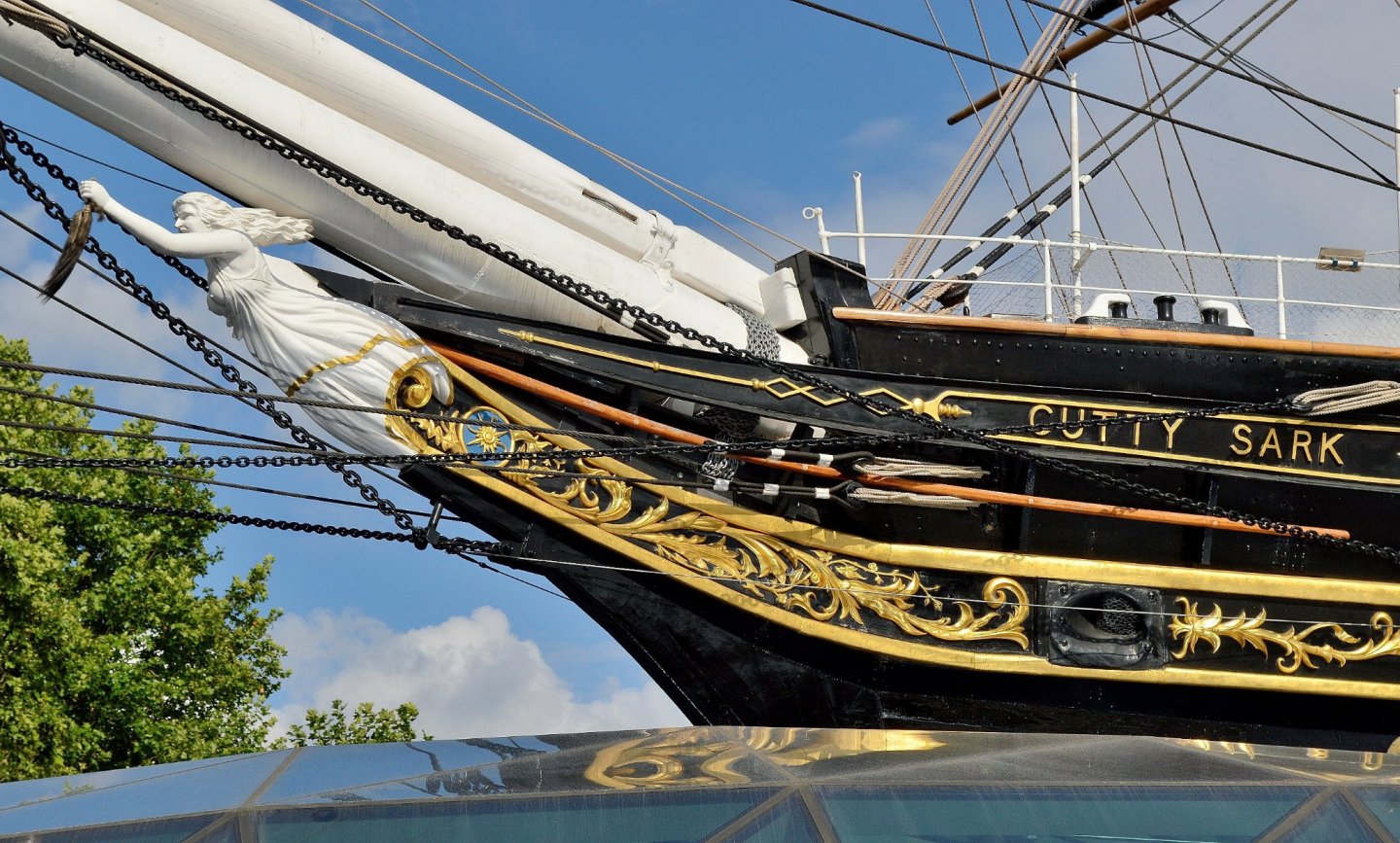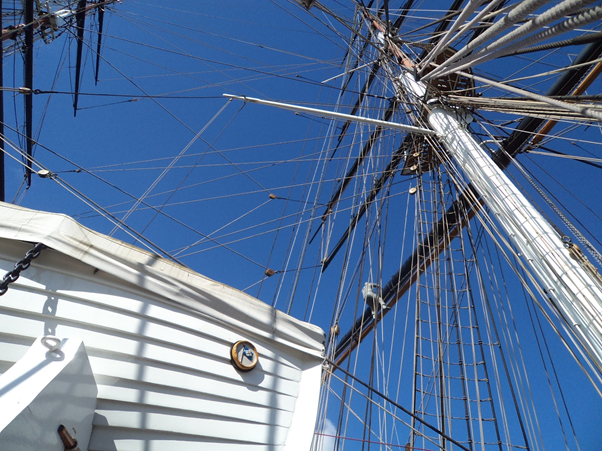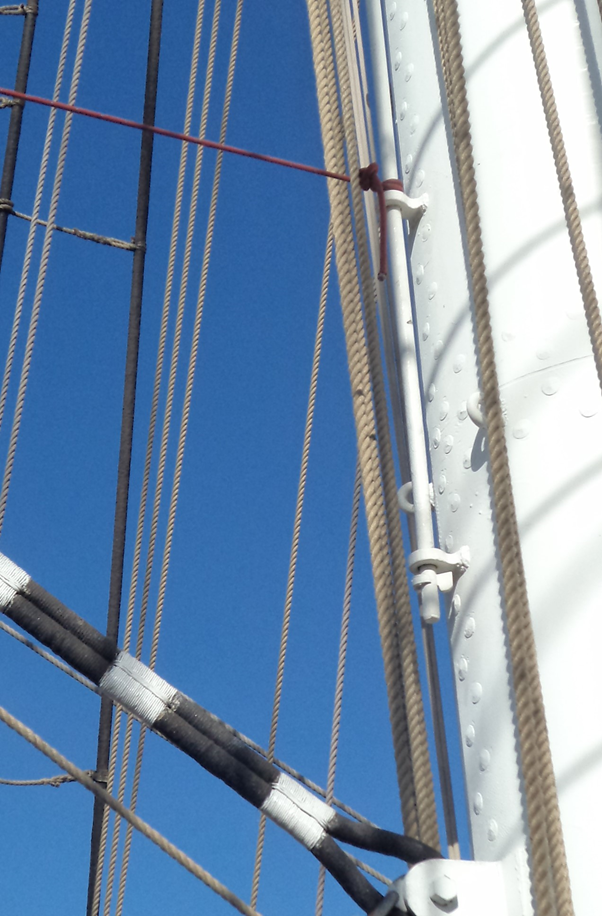
TIPP
-
Posts
8 -
Joined
-
Last visited
Content Type
Profiles
Forums
Gallery
Events
Posts posted by TIPP
-
-
On 2/13/2021 at 7:16 PM, shipman said:
Sorry to respond so late to your post (#161) but I was just browsing and saw your question about the rails on the bow of Cutty Sark.
These rails were removed from Cutty Sark when her new figurehead was fitted recently giving an opportunity to photograph them.
The rails are variously known as Middle Rail or Third Rail. They are made of teak and elliptical in cross-section, measuring 2½ inches top to bottom, 2 inches thick and 20 feet long. They are slightly convex to fit the shape of the bow.
The leading end is tapered and the after end is rounded.
Although they are undoubtedly decorative, they would certainly have had a practical function and here opinions differ. My best guess is that this rail was there to protect the guilded scrollwork and name on the trailboards from being ‘snagged’ and damaged by lines leading over the bow.
These could include headline mooring ropes, anchor cables (particularly when the anchor was ‘catted’ with the cable still attached), the fore tack and the sheet from a Jamie Green sail, carried under the bowsprit.
I would welcome any more knowledgeable explanation of their purpose.
Best wishes for your project.
- shipman, FrankWouts and Keith Black
-
 3
3
-
Cutty Sark’s Spencer sail
According to Captain Woodget, who was interviewed by Basil Lubbock during the writing of his book “Log of Cutty Sark”, the Spencer was never much used by him. An exception was when the ship was running dead before a heavy following sea, with the headsails only drawing when she rolled or yawed, the Spencer was sometimes set to ease the ship with the spanker brailed in.
It was generally kept bent and furled against its jackstay on the after side of the lower main mast.
The sail is set with an outhaul that runs through a block near the end of the spencer gaff, back to the main mast above the gaff, alongside the chain gaff lift, to a block, thence down to belay on its pin on the mast band. The inhaul runs under the gaff and also back to the mast and down to its pin on the mast band.
The photograph shows the outhaul and inhaul shackled together beneath the gaff.
The gaff is controlled by vangs which belay to the bulwark pin rails on either side, beneath the boat skids.
The block and halyard at the peak of the gaff is a signal hoist, not related to the sail.
-
The clew garnets for all three coarses run from spectacle clew irons shackled to the clews of the sails, directly up to the coarse yard. For most of her time in clipper rig, the coarses were 'clewed to quarters' meaning the clew of the sail was hoisted diagonally inboard towards the mast. There were a few occasions when the coarses were clewed vertically up to the yardarms, but this was not normal practice. The coarse clew lines lead through blocks on the coarse yard and then down the fore side of the lower mast to be belayed on pins (port & starboard) on the foreward fife rail at the foot of the foremast.
So, there is no fairlead shown on the diagram for the coarse clew because no fairlead was used.
-
The original arrangement of the foc'sle was altered after the ship left Falmouth in 1936, most likely when she was refurbished as a visitor attraction in Greenwich in 1954. The single central companionway to the anchor deck was removed and replaced with twin companionways, one either side of the central windlass, thereby making visitor circulation easier. In the process the curved pin rails at the break of the foc'sle, described by Longridge, were removed.
Today, the three headsail sheets belay to the three pins on the pin rails abaft the heads on either side (see my pics attached).
The fore topmast staysail sheet occupies the foremost pin and the flying jib sheet, the aftermost pin (This follows standard practice that the highest sail - or in this case, the furthest outboard - takes the aftermost pin in a set.)
-
Here is a picture of Cutty Sark at the time of the Festival of Britain (1951). There is reference to the ship in the Official Guidebook, but I can find no picture of her as an exhibit. The idea was to 'test the water' to see if there was enough interest to justify raising the money for a permanent home for her. (There was !!).
- shipman and FrankWouts
-
 2
2
-
On 12/17/2020 at 6:22 PM, shipman said:
As a cadet training ship the decks were altered drastically, at least 8 pairs of boat davits and across deck partitions and extra covered companionways.
I wasn't aware she was used at the Festival of Britain which was a very popular event. Where are the photo's that must have been taken?
Time for more digging. It's unfortunate that everything on the internet is only there because someone could be bothered.
- shipman and FrankWouts
-
 2
2
-
On 12/15/2020 at 10:00 PM, Cirdan said:
This photos show the Cutty Sark in her days at Falmouth from 1922 to 1938. She was restored in accordance to her early days. The 2nd photo shows the middle ladder to the forecastle as it is shown by the Longridge model and the "early model of the Cutty Sark".
https://nmmc.co.uk/2019/11/150-years-of-the-cutty-sark/
[If you copy the URL of the photo into the adress bar of your browser you can see a high resolution pic. Due to the copyright I can't post it directly.]
We can assume that this (in the eyes of the restorer) was the original look of the forecastle. There are no pin rails. In the days of captain Woodget it was altered into the arrangement we can see today.
On 12/15/2020 at 8:04 PM, shipman said:I'd like to know how Woodget managed to take that photo (4).
Something not quite right there.





Cutty Sark by Bruma - Revell - 1:96 - PLASTIC
in - Kit build logs for subjects built from 1851 - 1900
Posted
Hi Shipman
When launched, Cutty Sark had only one deckhouse.
John Willis' original specification for the construction includes:
1.Deck House. To be iron framed and plated with Teak and panelled. Galley to be fitted at after end and to be properly lined in wake of cooking range with sheet iron. Floor to be neatly tiled with coloured tiles. Funnel to be of galvanised iron. Fore end of house to be fitted for Carpenter, Sailmaker, Boatswain, Apprentice, etc. and of a size as may be required.
When used as accommodation for up to 8 apprentices, this deckhouse was known as the HALFDECK.
For the maiden voyage of 1870 all the ABs were housed in the fo'c'sl head, on the level of the 'tween deck, accessed only by a single companionway leading down from the weather deck immediately abaft the anchor windlass. This arrangement was soon deemed impractical because it took the men too long to get up on deck when needed in a hurry.
The result was the addition of a second deckhouse for the crew and their former space was given over to storage space.
Their 'luxurious' new deckhouse continued to be referred to as 'the fo'c'sl' and the watch off duty were always 'the watch below'.